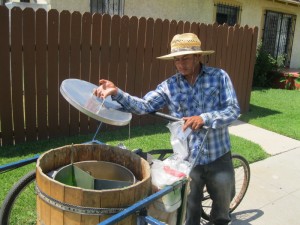In June 2012, I embarked on research to examine the wide disparities in health and longevity between neighborhoods just miles apart. It’s not unusual, especially in urban areas, to find that people living 10 or so miles from each other will have up to a 20-year gap in life expectancy.
I reported on this topic as a science and health writer with the Bay Area News Group (Contra Costa Times, San Jose Mercury News and Oakland Tribune) including this four-part series called “Shortened Lives.”
And poorer communities are on the losing end of this gap, coping for with more heart disease, diabetes, cancer, asthma and other diseases, as well as mental challenges. Deprivation and stress account for much of the disease burden. And the term “deprivation” covers a lot of issues – lack of access to good food and safe places to exercise, limited job and educational opportunities, lacking a feeling of security in one’s neighborhood and financial strain, to name a few.
But my research goes far beyond just examining this crisis. It’s focusing on what’s being done to shrink this gap. The problem is well known, but what far fewer know about are promising interventions that are making a difference.
Many advocates rightly point to this wide gap in health and life span as unfinished business of the Civil Rights Movement, as it largely affects blacks and Hispanics in the United States. (But not exclusively: Poor whites in the United States, largely in rural areas, also suffers similar gaps compared to wealthier whites.)
I’ll be examining a few major initiatives around the nation, especially the largest privately-funded one run by the California Endowment. It’s called “Building Healthy Communities,” and I spent much of the summer reporting on it. This current crop of blog posts come from that reporting. Rather than explaining the healthy communities’ campaign with each post, I’ll summarize it here and provide a link in all blog posts that reference it.
It came about because Dr. Robert Ross, the CEO of the California Endowment, grew disillusioned with the limits of what medicine could heal after working in a Camden, NJ community clinic as the crack epidemic broke out in the early 1980s. He realized his Ivy League medical education hadn’t given him the tools to deal with healing the social ills that create so many medical emergencies and chronic sicknesses. So he turned his attention to healing communities, not just individual patients. From that pivot in his career, the Endowment’s “Building Healthy Communities” initiative was ultimately born.
The California Endowment is the state’s largest private foundation, with some $3.7 billion in assets. In 2010, Ross and the board of directors launched the “Building Healthy Communities” campaign, and committed most of the organization’s grantmaking to it – $1 billion over 10 years. The nonprofit thoroughly researched the most distressed communities in the state, and found ones with the organizing strength and resiliency to create a better future – with some outside assistance. In exchange for hard work and inspired thinking on the part of the 14 communities, the Endowment committed to leaving them on a trajectory toward far better health and well-being, especially for the community’s children, when the initiative winds down in 2020.
These are the 14 communities participating in the campaign: Del Norte County, a rural area on the Oregon border; neighborhoods in Sacramento, Oakland, Richmond, Long Beach, Santa Ana and San Diego, near the Mexican border; two in Los Angeles – South Los Angeles and Boyle Heights; five rural or semi-rural communities – Salinas, Coachella Valley, South Kern, Fresno and Merced.
The initiative is deploying the best strategies known to bring about social change at the community-wide level, based upon examining several decades of successes and failures. In short, it rests on local leaders and community-based organizations engaging residents and local politicians to tackle major challenges stymieing progress and growth in the area. It’s all about organization, community enthusiasm, rigorous research and measuring results along the way. The initiative is strongly focused on improving schools, because health is so strongly linked to educational status and the critical thinking that education instills. And prevention is the mantra, as it’s so much more cost-effective and humane than coping with illnesses after they emerge.
And the campaign works with the nonprofits that the Endowment funds, meeting regularly and agreeing upon long-term outcomes to improve the community. The nonprofits still operate independently, but expand their mission to include the broader shared mission. The results can be exciting, as I describe in this post.
The initiative, however, goes beyond community level work by leaders, nonprofits and residents, as they alone don’t have the resources to completely turn things around – not after decades of deprivation. It takes broader policy changes and new infrastructure to secure lasting change, and that can only come from regional, state or federal policy shifts.
To that end, the initiative also deploys a statewide team to educate citizens and lawmakers about important policy decisions in the works.
This is a thumbnail sketch, and you can find more information here. I can attest that there are inspiring and exciting developments underway in these communities, with scores of smart, dedicated people determined to create real change. And there are some fantastic stories that never made the press. Some of these blog posts aim to partially fill that gap.








